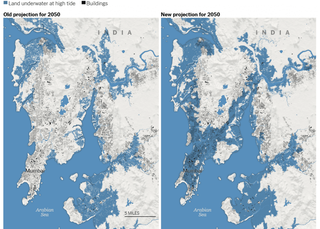Rising sea levels are on track to destroy the homes of 300 million people by 2050, and submerge much of Mumbai and other coastal Asian cities if carbon emissions do not change and cities do not add or improve measures to protect shorelines.
The new estimate of people affected, published in the journal Nature Communications, is more than three times the number scientists previously believed would be displaced by increased sea flooding. For India specifically, the new estimates — 35 million affected — are a sevenfold increase on previous estimates. The new report is based on more accurate calculations of coastline elevation around the world; previous analyses used less sophisticated instruments that couldn’t account for tall buildings and trees, thus yielding less accurate elevation measures.
“As the tideline rises higher than the ground people call home, nations will increasingly confront questions about whether, how much and how long coastal defenses can protect them,” Scott Kulp, the lead author of the study and a senior scientist at Climate Central, told The Guardian.
The answer, for many of India’s coastal metros, is not long. According to images based on the new projections and published by the New York Times, much of Mumbai, for instance, will be submerged by rising seas by 2050.
Image Credit: New York Times
Mumbai is far from alone. According to report estimates, the cities of Bangkok, Shanghai, and Alexandria, Egypt, will be submerged; most of Vietnam will also be underwater.
But this is not even the worst-case scenario. These more-exact estimates are based on the assumption that global emissions reduce in line with the levels outlined in the 2016 Paris Agreement on climate change — but many countries are not currently on course to meet their target reductions, The Guardian reports.
Experts warn affected countries — like India, which ranks 18th in the world for longest coastline, according to the World Resources Institute — should start preparing not only to mitigate the effects of rising sea levels but also to handle large numbers of internally displaced people. Still, they note, there is no example in modern history of how to prepare for and facilitate this scale of population shift. In India’s history, the number of displaced people during Partition — roughly 14 million — pales in comparison to the at least 35 million estimated to be displaced from their homes due to rising seas over the next 30 years.
“We’ve been trying to ring the alarm bells,” Dina Ionesco, of the International Organization for Migration, told the New York Times. “We know that it’s coming.”





